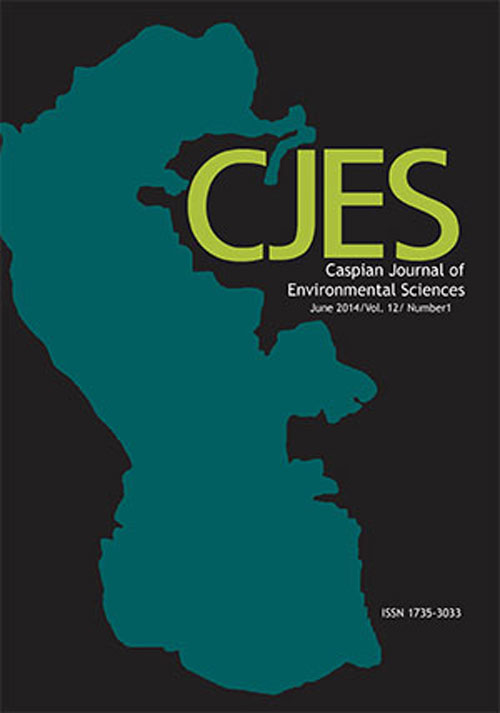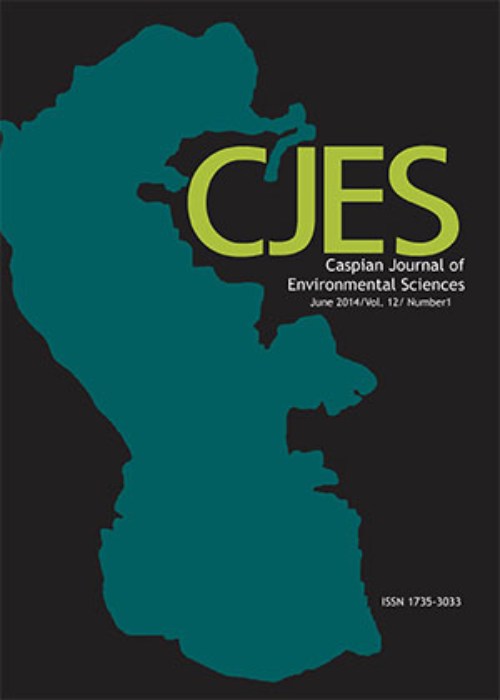فهرست مطالب

Caspian Journal of Environmental Sciences
Volume:16 Issue: 1, Winter 2018
- تاریخ انتشار: 1396/12/28
- تعداد عناوین: 8
-
-
Pages 1-11A key aspect of sustainable development in a country is how energy, environment and economic sectors interact. Greenhouse gas emissions and their impacts are among important environmental issues that have been in focus. The increase in the concentration of these gases in atmosphere to levels above the natural level results in global warming, depletion of the Earths protective layer against harmful solar radiation, and threatening whole natural life. The present study aimed at examining the factors affecting CO2 emission in Iran in 1981-2015. The studied variables included per capita CO2 emission, fuel price, per capita production, and per capita energy consumption. The relationship was examined by auto-regressive distributed lag (ARDL) model. It was found that CO2 emission is related to actual price of fuel indirectly and to per capita production and per capita energy consumption directly. According to the findings, 1% higher price of fuel would decrease CO2 emission by 0.14%, while 1% higher per capita production would increase it by 0.59%. Given the effectiveness of subsidy reform policy and the increased price of fuel on the alleviation of greenhouse gas emissions by road transport sector, it is advisable to gradually increase fuel price until it reaches FOB price in the Persian Gulf.Keywords: CO2 Emission, Environment, Fuel, Kuznets Curve, ARDL
-
Pages 13-23The Caspian kutum, Rutilus kutum (Kamensky 1901) specimens were sampled by purse seine in the northern Iranian coast of the Caspian Sea at four locations: Feridoonkenar Shahed, Mahmoudabad Khoram, Lariim Azadi fishing coop, and the Shiroud River in Ramsar city. Back-calculation is a retrospective method of estimating the characteristics of growth of fish in terms of length and rate of growth in the years preceding capture. Back-calculation of fish lengths at previous ages from scales or otoliths is a widely used approach to estimate both individual and population growth history. The back-calculated lengths of the Caspian kutum,Rutilus kutum (Kamensky 1901) were obtained using six different models, namely scale proportional hypothesis , body proportional hypothesis , Fraser Lee, nonlinear scale proportional hypothesis, nonlinear body proportional hypothesis, and the newest method, Morita Matsuishi model. The results showed that the preferred back-calculation models is Fraser Lee model for both males and females, while the nonlinear body proportional hypothesis is only for the females.Keywords: Northern Iran, Back, calculation, Rutilus kutum
-
Pages 25-36The study was conducted to analyze the existence of bioactive phytochemicals extracts in green alga Scenedesmus dimorphus and their antimicrobial role. Various solvents such as methanol, ethanol, N-hegzane and diethylether were used for extraction. The extracts of of Scenedesmus dimorphus were tested against two Gram - positive bacteria (Bacillus subtilis and Micrococcus luteus), a Gram - negative bacterium (A. hydrophila) and Escherichia coli by the agar well diffusion method. Four different methanolic, ethanolic, hexane and diethylether extracts showed effective inhibition against different bacterial pathogens. Diethylether extract was very effective against bacterial strains compared to other extracts. Methanolic extract effectively inhibited A. hydrophila in comparison with other extracts, while ethanolic extract did not have any inhibitory effect on the bacterium. Methanolic, ethanolic, hexane and diethylether extracts were analyzed by GC mass. The most abundant compounds in methanolic extract of S. dimorphus included esters, plasticizer compound and terpens, while in the ethanolic, N-hexane and diethylether extracts, the most abundant compounds were found to be plasticizers, hydrocarbon and esters. These results indicate the presence of promising antimicrobial compounds in the examined algal species. Further phytochemical studies are required to elucidate the structutre and detailed activities of these compounds. So, we achieved antimicrobial activity in the methanolic, ethanolic, hexane and ether extracts of green microalgae against some pathogenic bacteria as well as employing GC mass autogram for S. dimorphus extracts for preliminary detection of active constituents.Keywords: Scenedesmus dimorphus, Antibacterial, antimicrobial, Aeromonas hydrophila, Bacillus subtilis
-
Pages 37-45The toxic effect of herbicides on non- target microorganisms may influence degradation of organic matter resulting in changes to nutrient cycling. In the present study, different strains of bacteria incubated in media containing different concentrations of glyphosate and paraquat were assessed over a period of two incubation terms. The deleterious impact of the herbicide was observed as glyphosate and paraquate treatments led to a reduction in the bacterial population. Analysis of the colony- forming unit (CFUs) showed a declining in microbial growth from 0 to 24 hours of incubation in all concentrations of glyphosate followed by a steady declining rate of the bacterial population after 48 h. The greatest bacterial population developed in media containing concentrations of glyphosate and paraquat was observed with strains S13.3, while strains S55 and S35 showed the lowest biomass production in response to all concentrations of glyphosate and paraquat. Based on the results obtained, strain S13.3 was determined to be resistant to the herbicides examined and may be useful for bioremediation of these compounds in soil.Keywords: Herbicides, Microbial populations, Microbial biomass, Glyphosate, Paraquat
-
Pages 47-63This paper focuses on heavy metal distribution patterns in sediments of central Guilan (CG) and east Mazandaran (EM) in the south Caspian Sea coasts, north of Iran. Sediment sub-samples were retrieved from core and surficial samples in different environments of marine and coastal lagoons as well as coastal outcrops. Inductively Coupled Plasma Mass Spectrometry and Atomic Emission Spectrometry (ICP-MS and ICP-AES) analysis were used to determine the metal chemistry. Concentration of the selected heavy metals exhibited variations through sediment samples which are partially related to grain size and organic matter content. Geoaccumulation index and statistical procedures have been implemented for analyzing the absolute metal values. Result of the geoaccumulation index demonstrated that the metal distribution reflects the influence of geological background of the watershed area. Some elements including Pb, Ni, Cu, Sr and Ba showed elevated concentration in the CG that could be attributed to development of industrial activities. A comparison of the metal concentration in the marine sediments and the Late Holocene outcrops revealed that the level of the metals concentration at the sea generally corresponds to natural background. The northern part of Iranian multi-lithological catchments basin is the main source for the sediments that drained by the rivers to the South Caspian Sea basin.Keywords: Caspian Sea, Geoaccumulation Index, Heavy Metals, Principal Component Analysis, Sediment
-
Pages 65-71This study focuses on the carrying capacity estimation for Darkesh forest in Northeast Iran. Four factors were used for estimating the carrying capacity including tourist flows, size of the area, optimum space available for each tourist, and visiting time. Results showed that the physical carrying capacity was 2727 ha or 165 visitors/day, while the real carrying capacity was 2719 ha or 132 visitors/day. An average of 200 tourists per day visited the park during 2015, which was much higher than the estimated carrying capacity. Development of recreational uses in the study area would also affect the forest production and other benefits in long term. This study suggested that to prevent intense use of the forest area, a plan must be developed. On the other hand, the number of visitors has to be precisely calculated in order to maintain healthy forest stands and to secure the ecological benefits for future generations.Keywords: Estimation, Carrying capacity, Management, Darkesh forest, Iran
-
Pages 73-86During recent years, oak decline has been widely spread across Brants oak (Quercus Brantii Lindl.) stands in the Zagros Mountains, Western Iran, which caused large-area forest dieback in several sites. Mapping the intensity and spatial distribution of forest dieback is essential for developing management and control strategies. This study evaluated a range of geostatistical and interpolation methods to explore the spatial structure and provide area-based maps of the intensity of forest dieback across a representative test site - Ilam Province - that was severely affected by Oak decline. The geostatistical analysis provided in-depth measures of the spatial structure amongst the selective sampling units (120 quadratic sample plots of 1200 m2), which eventually resulted in an area-based maps of dieback intensity. The accuracy of the applied methods was assessed by mean error percentage (%ME), root mean squared error percentage (%RMSE) and coefficient of determination (R2). Results showed moderate spatial structure within the sampling units. Moreover, cokriging (associated with soil humidity and aspect as independent variables) approach resulted in the highest accuracy, followed by two other methods of kriging and Radial Basis Function. Results suggested that cokriging can accurately estimate the intensity of dieback and its spatial distribution in the study area. According to this, an average dieback intensity of 18.12 % was estimated within the study area.Keywords: Oak decline, Spatial structure, Interpolation, geostatistics, Zagros
-
Pages 87-94Minerals play an essential role in the normal vital process.Calcium, phosphorous and magnesium are the most abundant minerals. Vitamin D and parathyroid hormone play a key role in regulation of their homeostasis as well. The aim of this study was to evaluate calcium, phosphorous, magnesium, vitamin D and parathyroid hormone on 30 Caspian horses of Guilan Province (south of the Caspian Sea) in two different seasons. So that, 15 stallions and 15 mares were sampled at the age groups ≤ 3 years and > 3 years respectively. Fasting blood samples were collected twice, in August and January 2015 from jugular vein of horses. Serum calcium, phosphorous and magnesium were measured by colorimetric methods, while 25(OH)D3 and parathyroid hormone were measured by ELISA. The calcium (11.50 vs. 14.25 mg.dL-1), magnesium (2.13 vs. 3.72 mg.dL-1) and vitamin D (1.66 vs. 2.48 ng.ml-1) levels were lower in winter than in summer (P 3 year - old ones (PKeywords: Caspian horse, Calcium, Phosphorous, Vitamin D, Parathyroid hormone


